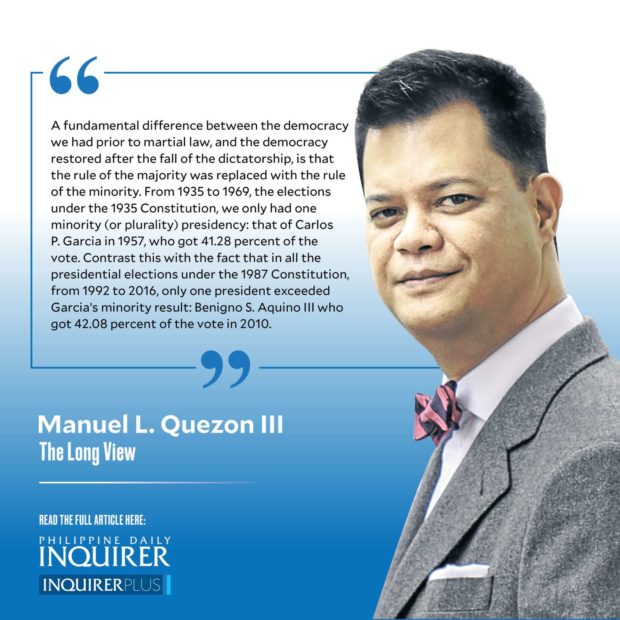Rule of the minority
A fundamental difference between the democracy we had prior to martial law, and the democracy restored after the fall of the dictatorship, is that the rule of the majority was replaced with the rule of the minority. From 1935 to 1969, the elections under the 1935 Constitution, we only had one minority (or plurality) presidency: that of Carlos P. Garcia in 1957, who got 41.28 percent of the vote. Contrast this with the fact that in all the presidential elections under the 1987 Constitution, from 1992 to 2016, only one president exceeded Garcia’s minority result: Benigno S. Aquino III who got 42.08 percent of the vote in 2010. All others in the same period failed to exceed 40 percent when all others in the period before 1986 had at least 50 percent of the vote. One could argue — adopting either side’s claim of victory — that the last time the country had a majority presidency was with the election of Corazon C. Aquino in 1986.
This had a profound effect on the way campaigns are run, beginning with the controversial campaign of Fidel V. Ramos which defined the role parties would play in our newly-restored democracy. That role would be, at best, a passive one of convenience: the administration party President Aquino had reluctantly allowed to be created as a necessary evil, failed to hold together when confronted with the challenge of refereeing the selection of Aquino’s successor. Unable to counter Ramon Mitra Jr., Ramos bolted the party, and found a convenient vehicle courtesy of Raul S. Manglapus. Ever since, party affiliation has neither been a core political identification, nor more than a vehicle for obtaining election returns and authorizing poll watchers, for aspiring candidates. (Of our post-Edsa presidents, only Aquino III could be considered a loyal party man.)
Article continues after this advertisementThe nature of our presidential election — multiparty contests, with no run-off election — means it is virtually impossible for a candidate to achieve a majority. Because of this, the traditional idea of a presidency being based on a majority mandate, though still a powerful one, will have had no basis in fact for 30 years, come the 2022 elections. It means that tactically speaking, the presidency is anchored on two negatives: subtracting from the score of the perceived frontrunner, while subtracting from the number of viable candidates close to the actual winner. In practice, this means a take-no-prisoners approach to demolishing the standing of the frontrunner, while quietly working to attract the supporters of less viable candidates who, however, are closer in orientation to a stronger rival.
If we assume that whichever way one slices and dices it — whether it will be a Duterte-Duterte tandem, or two supposedly independent tandems with a Duterte (one for the presidency and the other for the vice presidency) in each, or only one #Daughterte seeking the presidency — one thing potentially problematic for such a campaign is the careless though clever propaganda of the past five years, which boldly (and baldly) claims having been a landslide victory crowned with spectacular majorities in public opinion approval. On the eve of lockdown, for example, some news outfits have pointed to surveys showing the President leading the pack for the 2022 vice-presidency — but by a mere handful of points and below 20 percent at that. What happened?
The pros will say, nothing’s happened: nothing’s been formally announced, which is why there isn’t really any public opinion to speak of. And they would be right to say so. We don’t know what the impact on public opinion of a formal declaration of candidacy would be; but there is one snapshot of public opinion that should give all the players pause. It was a Pulse Asia rider question commissioned by Sen. Miguel Zubiri. Respondents nationally-speaking said only 35 percent would go out and vote if the number of COVID-19 cases in their barangay is high; 46 percent said they’d stay home; a high percentage, 19 percent were undecided. The numbers are higher where the biggest votes are, in the NCR (35 percent would vote; 57 percent would not, only 7 percent are undecided), and Balance Luzon (29 percent would vote; 50 percent would not, a big 21 percent are undecided), while in the Visayas (32 percent would vote, 37 percent would not; a whopping 32 percent are undecided) and Mindanao (50 percent would vote, 40 percent would not, only 10 percent are undecided) which, together, more or less equal Luzon show an advantage for the administration and a disadvantage for its critics (if we assume a significant swathe of the Visayas is anti-administration).
Suddenly, what would normally seem an administration disadvantage — a continuing pandemic — turns into a plus. Gone are the days of Amang Rodriguez when politics was addition; it’s now an exercise in subtraction.
















